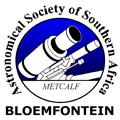Solar
Observations
|
The
Solar Observation members of ASSA Bloemfontein study
the properties of Earth's nearest star, the Sun, doing sunspot
counts, measuring solar activity etc.
|
| Solar
Bulletins - ASSA Solar Section |
| Find reports of solar observation data on
solar activities such as sunspots, solar flares,
solar wind, geo-magnetic storms etc, by the solar section of ASSA. Access the national web page (bulletins appear at the upper right corner). |
| Solar CD - order your copy |
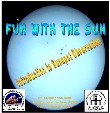
|
"Fun with the Sun!" - all the information you need to start off with your OWN solar observations. Contains solar images, interesting facts and solar data as well as how-to's on solar observations. Cost: R30 (including postage in South Africa). Overseas orders, please request a quote. Send your order and postal details to Jacques van Delft, national Solar Section director. |
| Solar
Picture |
|
Solar
image on 1 April 2006
(credit:
Jacques van Delft)
|
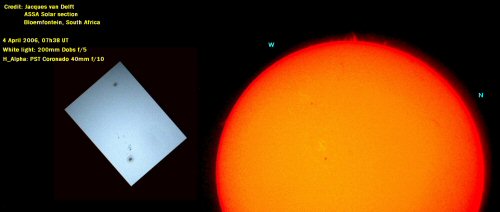 |
|
| Quick
facts about the Sun |
| Mass
(kg) |
1.9891·1030 |
| Diameter
(km) |
1.392·106 |
| Escape
velocity (km·s-1) |
617.7 |
|
Luminosity (watt) |
3.846·1026 |
|
Mass conversion rate (kg·s-1) |
4.3·109 |
|
Spectral type |
G2 V |
|
Absolute magnitude |
+4.83 |
|
Apparent visual magnitude |
-26.7 |
|
Distance from Earth (km) |
1.47-1.52·108 |
|
Core pressure (bar) |
2.477·1011 |
| Core
temperature (°C) |
1.571·107 |
|
Rotation period (hours) |
609.12 |
|
Speed relative to nearby stars (km·s-1) |
19.4 |
|
| How
to begin with solar observations |
|
Information pamphlet for interested observers
The Director of the Solar section has compiled an invitation
for any interested beginner or advanced observer. Download
the word document.
The Sun
At
over 1.4 million kilometers wide, the Sun contains 99.86 percent
of the mass of the entire solar system: well over a million
Earths could fit inside its bulk. The total energy radiated
by the Sun averages 383 billion trillion kilowatts, the equivalent
of the energy generated by 100 billion tons of TNT exploding
each second.
But the energy released by the Sun is not always constant. Close
inspection of the Sun's surface reveals a turbulent tangle of
magnetic fields and boiling arc-shaped clouds of hot plasma
dappled by dark, roving sunspots. [Read
on...]
|
| Solar
Activities of the Centre and ASSA |
 |
The
Solar observation activities concentrate around studies
of the Sun's activity and the impact it has on various aspects
of Earth's environment.
Observations of the Sun takes place from Boyden Observatory,
where the 20 cm coelostat is used as well as from members'
homes in the City and surroundings areas. Most active is
Jacques van Delft, who does most studies from Wepener in
the Free State. |
Current
activities include:
- observing solar flares and sunspots on a regular basis or
when increased storm activity are detected by Satellites
- the impact of the Sun on climate changes and agriculture (by
Jacques van Delft)
- observing and reporting planetary-sun transits
Go to the web page for national ASSA's Solar
Section.
|
| Solar
telescopes of the world |
There are three main types of solar telescopes:
Coelostat: "Optical device used to
follow the path of a celestial body and reflect its light into
a telescope; has a movable and a fixed mirror"
Heliostat: "An instrument consisting
of a mirror moved by clockwork, by which a sunbeam is made apparently
stationary, by being steadily directed to one spot during the
whole of its diurnal period" (these
two definitions from the handy WordWeb
dictionary) - one flat mirror tracks
the beams of the sun and redirect it to a stationary mirror which
collects the light and send it to the processing component (e.g.
camera).
Siderostat: The sideriostat is a variation
of the heliostat. The difference is that the siderostat must be
moved in two coordinates while it is tracking the sun.
List of biggest solar telescopes in the world
with large focal
length:
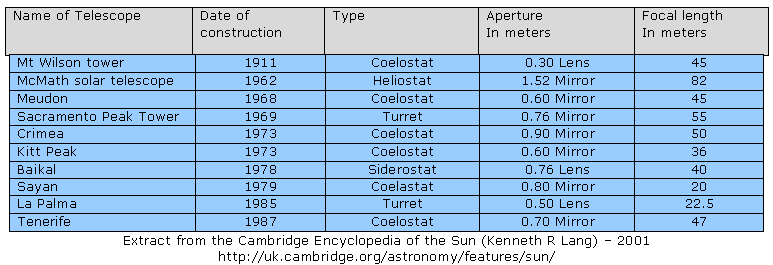
List of biggest solar telescopes in the world with
short focal length:
 |
| Dates
to remember |
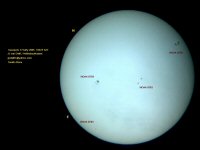 |
Annular solar eclipse of the Sun - 22 September 2006 (refer
to 2006 Sky Guide for contact times or go to the JHB Planetarium's site)
Winter Solstice - 21 June 2006, 14h26
Summer Solstice - 22 December 2006, 02h22
|
|
| National
ASSA Solar Section links: |
Go to the web page for national ASSA's Solar
Section.
National ASSA Transit of Venus report page: ASSA
ToV |
| Contact
Us |
For more information or if you would like to participate in solar
observations, contact Jacques van Delft at +27 (0)82 812 5907.
|
|
